|
|
NYSG's Social Media Review: Early February 2017
By Paul F on Feb 3, 2017 at 2:52 PM
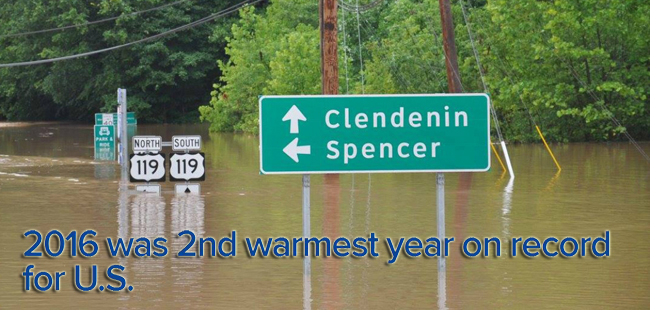
Flooding in West Virginia contributed to 2016's billion dollar disaster figures. Credit: West Virginia DOT
2016 was 2nd warmest year on record for the United States. Some 15 weather and climate disasters caused 138 deaths and $46B in damages, as reported by The National Oceanic and Atmospheric Administration (NOAA) in its early January's Annual 2016 U.S. State of the Climate Report: http://ow.ly/xpUi308EYhG
This was the second highest number of billion-dollar events in the 37-year record, one less than the 16 that occurred in 2011.
2016 also marks three consecutive years of record warmth for the globe, according to NOAA's National Centers for Environmental Information: https://t.co/5sDkZyODpI.
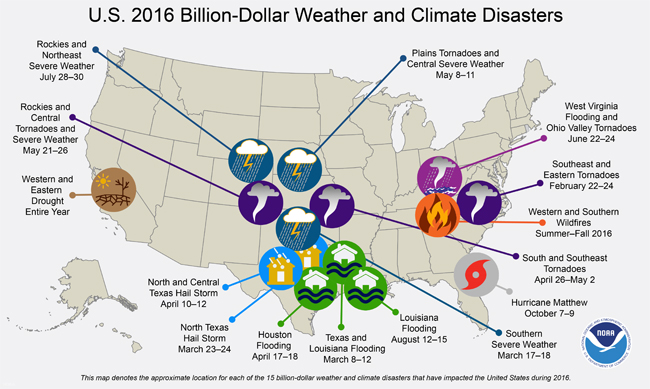
With eight consecutive record warm months kicking off the year from January to August, the globally averaged temperature over land and ocean surfaces for 2016 ended as the highest since record keeping began in 1880, according to NOAA scientists.
The average temperature across global land and ocean surfaces in 2016 was 58.69 degrees F or 1.69 degrees F above the 20th century average. This surpassed last year’s record by 0.07 degrees F. Since the start of the 21st century, the annual global temperature record has been broken five times (2005, 2010, 2014, 2015, and 2016).
How unusual is 2016's record-temperature three-peat, and will the hot streak continue in 2017? NOAA Climate.gov's Beyond the Data blog offers insights: http://ow.ly/zYV9308F2LQ.
Also: NOAA Climate.gov's blog examines 2016, identifying some of the most meaningful climate and weather events from the year: http://ow.ly/wLYJ308F3PR.
Top 10 Trending News Stories from NOAA's New York Sea Grant ...
(1) JOB OPPORTUNITIES >>> Applications are currently being accepted for two positions:
A. A new full-time Great Lakes Coastal Processes Specialist. A review of submissions received will commence on February 13, 2017 for this position, which will be located at either SUNY Oswego or Cornell Cooperative Extension of Wayne County in Newark, NY.
B. A new full-time Marine District Coastal Processes and Hazards Specialist. A review of submissions received will commence on February 27, 2017 for this position, which will be located in Stony Brook, NY.
You can see more on these topics at, respectively, www.nyseagrant.org/glcoastal and www.nyseagrant.org/marinecoastal.
(2) REQUEST FOR RESEARCH PROPOSALS >>> Pre-proposals are currently being accepted for NYSG's Biennial Research Call for 2018-2019. Deadline for online submissions is 4:30 PM on Monday, February 27, 2017. Approximately $120,000 per year for 2 years (beginning 2/1/2018) to support about 5-7 projects. Details and online submission portal at www.nyseagrant.org/proposals.
(3) FELLOWSHIPS >>> Graduate and/or postgraduates can apply for fellowships including: Great Lakes Commission – Sea Grant; and the Knauss Marine Policy. Deadlines, which are in mid-late February, vary, with details available at www.nyseagrant.org/proposals.
(4) YOUNG BOATER SAFETY CERTIFICATION >>> Successful completion of the free, 8-hour training program and same-day proctored exam on February 18th at the 2017 CNY Boat Show certifies youth ages 10 to 17 to legally operate a motorized boat or watercraft alone on New York waters. Pre-registration is required for the limited space seating: https://seagrant.sunysb.edu/articles/r/2698.
(5) SHIPWRECK COMES ASHORE AGAIN >>> Our Great Shipwrecks of NY’s ‘Great’ Lakes Exhibit will next visit Plattsburgh. This exhibit, which includes panels on Lake Champlain and Lake George shipwrecks, marks its fourth year in transit with the stop at City Hall from February 6th to April 28th, 2017: https://seagrant.sunysb.edu/articles/r/2699.
(6) LEARNING ON THE HUDSON >>> Understanding and protecting the ecological values of the Hudson Estuary's shoreline, marshes and narrow river channels is critical to maintaining and improving Hudson River habitats. More via our blog post from our Hudson Estuary Specialist and her recent research fellow: https://seagrant.sunysb.edu/blog/33.
(7) IT'S THE LAW >>> As of November 1st (and through May 1st) boaters, canoeists, kayakers, anglers and hunters who enjoy being on the water be aware that New York State law requires anyone in a boat that is less than 21 feet long on New York waters to wear a U.S. Coast Guard-approved flotation device: https://seagrant.sunysb.edu/articles/r/2695.
(8) SEA GRANT AT 50 >>> We continue our commemoration of "SeaGrant50," the year-long
anniversary campaign, by featuring some related coastal effort
milestones - both statewide and nationally - on our blog, www.nyseagrant.org/blog.
(9) E-NEWS >>> Check out an archive of our newsletter, NY Coastlines / Currents, the latest of which was e-distributed this past summer: www.nyseagrant.org/nycoastlines. While you're there, you can also sign up (if you haven't already done so) to receive our next issue, slated for release in late Winter / early Spring 2017.
(10) BEST OF 2016 >>> If you haven't seen our look back at 2016's trending coastal science news from Sea Grant and NOAA, its federal partner organization, check out our Year-In-Review: www.seagrant.sunysb.edu/blog/35.
Top 12 Trending News Stories from NOAA ...

(1) SEEING SHADOWS >>> Six more weeks of winter? Predicting the arrival of spring for the entire United States is a tough job, but each February 2, Punxsutawney Phil gives it his best effort. Learn more about how the groundhog's predictions stack up against the U.S. climate record: http://ow.ly/b9kv308EGIJ.
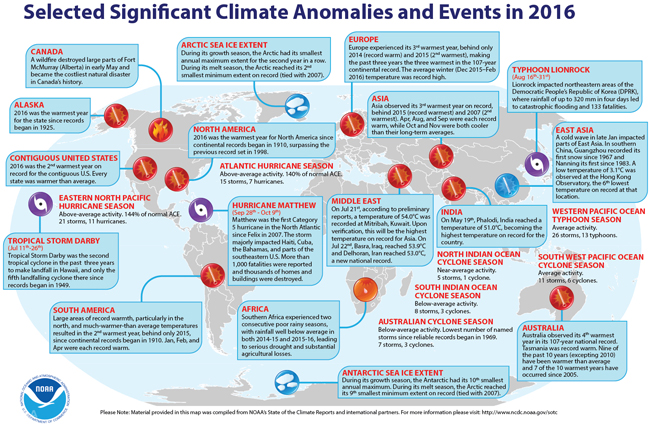
(2) GLOBAL & U.S. CLIMATE >>> According to NOAA's Annual 2016 Global Climate Report, the average temperature across global land and ocean surfaces during December 2016 was 1.42°F (0.79°C) above the 20th century average: http://ow.ly/eZRi308F2Vo.
This was the third highest departure from average for December in the 1880-2016 record. Only the Decembers of 2014 and 2015 were warmer.
As detailed in the Annual 2016 U.S. State of the Climate Report, the average temperature for the contiguous U.S. in December 2016 was 32.9°F, near the long-term average for the month: http://ow.ly/NKlK308F3cZ.
The northwestern quarter of the contiguous United States was generally cooler than average for the month, while the southern and Atlantic Coast states were warmer than average.
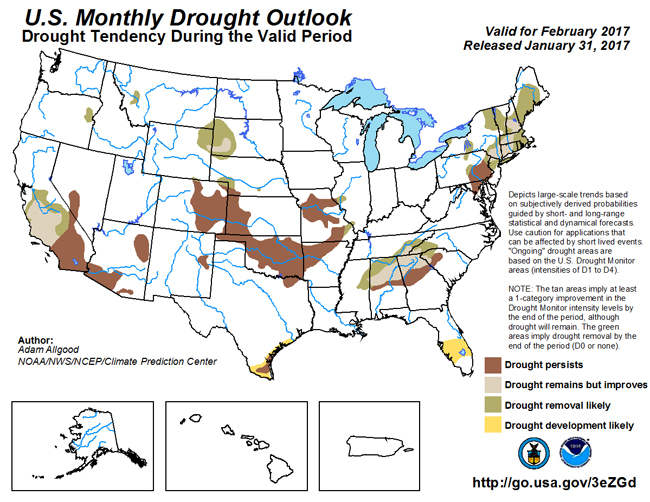
(3) U.S. DROUGHT >>> With an average of 18.95% of the country under drought conditions throughout the year, 2016 saw the smallest U.S. drought coverage since 2010.
In fact, for the first time since March 2011, there is no "exceptional drought" -- the worst classification on the U.S. Drought Monitor scale. Still, as NOAA's Deke Arndt explains, drought in California isn't over, despite January's soaking rains. Get the full recap: http://go.usa.gov/x96cp.
According to the January 31st U.S. Drought Monitor, moderate to exceptional drought covers 14.6% of the contiguous United States, a decrease from 16.1% the prior week. This marks the first time drought conditions have affected less than 15% of the Lower 48 states since June 2016: http://ow.ly/euBR308F1Kb.
NOAA National Weather Service's (NWS) Monthly Drought Outlook predicts drought improvement in central California, and parts of the northern Plains, New England and the Southeast through February: http://ow.ly/aTC4308EIxa.
(4) KID'S PLAY >>> NOAA offers up some online games for its young science fans: http://ow.ly/1Nsy308JfSC.
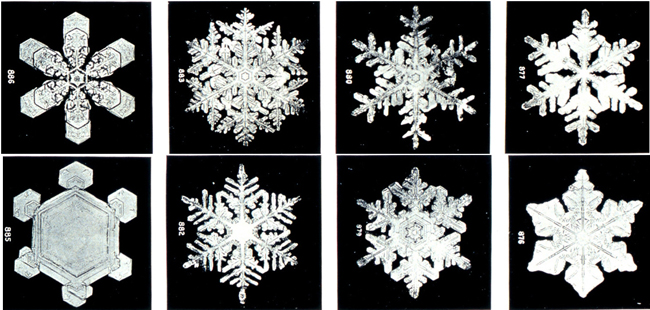
(5) COOL AS ICE >>> You might like or hate the cold white stuff, but do you know how snowflakes come to be? Get the science behind how snowflakes are formed: http://ow.ly/NJNI308EZPK.
ALSO: Get your snowstorm smarts on with six forecast tools to use this winter: http://bit.ly/2iadGdl.
(6) CLIMATE VS. WEATHER >>> Confused about the difference between climate and weather? NOAA Climate.gov has you covered with its back-to-basics Climate Data Primer: http://ow.ly/IIuq308F2ca.
ALSO: Both topics appear in New York Sea Grant's "Hudson River Estuary Climate Change Lesson Plan Series," www.nyseagrant.org/hvclimate.
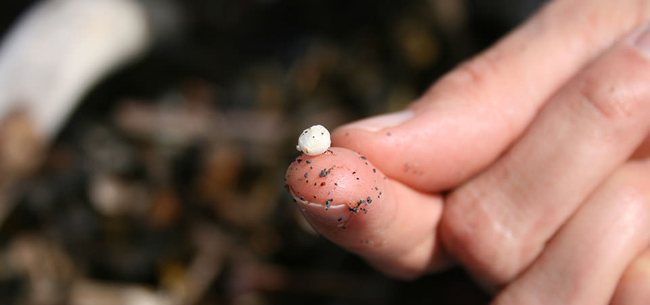
(7) ZOOMING IN >>> Microplastics, the recent topic of a Reddit "Ask Us Anything" discussion in mid-January with NOAA Marine Debris experts, are a macro problem in our oceans: http://ow.ly/nrcy308EXOK.
The majority of marine debris found around the world is made of plastic and can range from microbeads smaller than a sesame seed up to an 11-ton mass of abandoned fishing nets. Over time these plastics break down into what is called microplastics (smaller than five millimeters in size). More from Sea Grant at www.nyseagrant.org/microplastics.
(8) HEED THE WARNINGS >>> As NOAA's NWS reminds, there are many ways you can receive weather warnings. Check www.weather.gov for what you can expect today.
(9) RIDING THE WAVE >>> What is a wave and why are they fixtures in our oceans?: http://ow.ly/VFrK308EKIm.
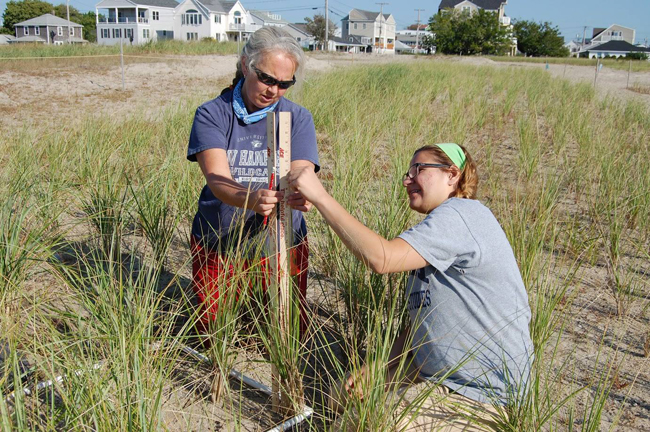
(10) PITCH IN >>> Do you love environmental #science? Want to make a difference? Become a NOAA Citizen Scientist -- There are lots of volunteer opportunities and ways to contribute: http://bit.ly/NOAACitizenSci.
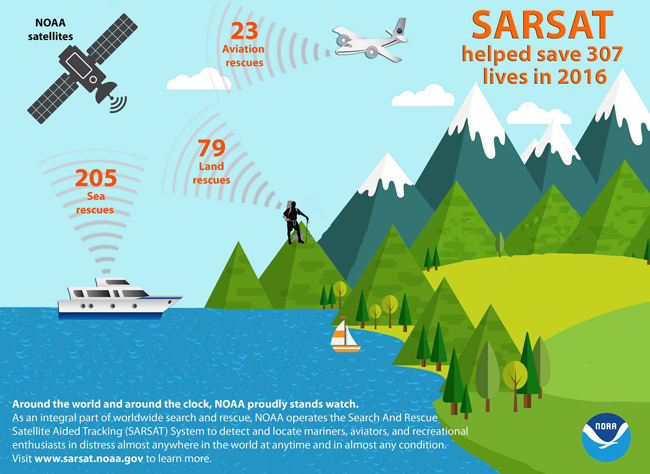
(11) GLOBAL IMPROVEMENT >>> NOAA Satellite and Information Service's GOES-16 is the first spacecraft in the org's next-generation GOES-R satellite series. Thanks to its advanced instruments, GOES-16 will capture higher-resolution images of weather patterns and atmospheric phenomena than any of NOAA’s GOES satellites to-date: http://ow.ly/7CcL308ELFO. More on its importance: http://goo.gl/8aWR9g and http://goo.gl/VE1dom.
ALSO: NOAA's satellites are also an important part of the Search and Rescue Satellite Aided Tracking System. Last year, they helped save 307 lives, including one rescue in the Bering Sea where forty-six crew members were pulled from their sinking fishing vessel: https://t.co/lk2DWAlUw7.
(12) WINTER SAFETY >>> Snow can be a danger long after it stops falling. NOAA's National Weather Service reminds that before you hit the slopes, make sure check out http://www.avalanche.org for current and forecast snow conditions. You can also find avalanche safety tips at weather.gov/avalanche.
ALSO: Cold weather can be life-threatening. If you can’t avoid being outside, NOAA's National Weather Service reminds you to follow these 3 steps and tell someone where you’re going: https://www.weather.gov/wrn/winter_safety, http://www.weather.gov/cold.
---
On www.nyseagrant.org ...
- Our "Trending Topics," such as climate change and green tips for coastal living, via a section on our homepage, www.nyseagrant.org.
- For the latest news from NYSG, check out our 'Currents' section, www.nyseagrant.org/currents, as well as our 'by-topic' archives, www.nyseagrant.org/currentsarchive.
- To keep tabs on all of NYSG's coastal science news, follow us on Facebook (www.facebook.com/nyseagrant), Twitter (www.twitter.com/nyseagrant) and YouTube (www.youtube.com/nyseagrant); Subscribe to our free news feeds (click the orange & white icon in the "Follow Us" navigation bar at www.nyseagrant.org); Sign up for our e-list in a few quick clicks at www.nyseagrant.org/nycoastlines. Our flagship publication, NY Coastlines / Currents, is published 1-2 times a year.
|